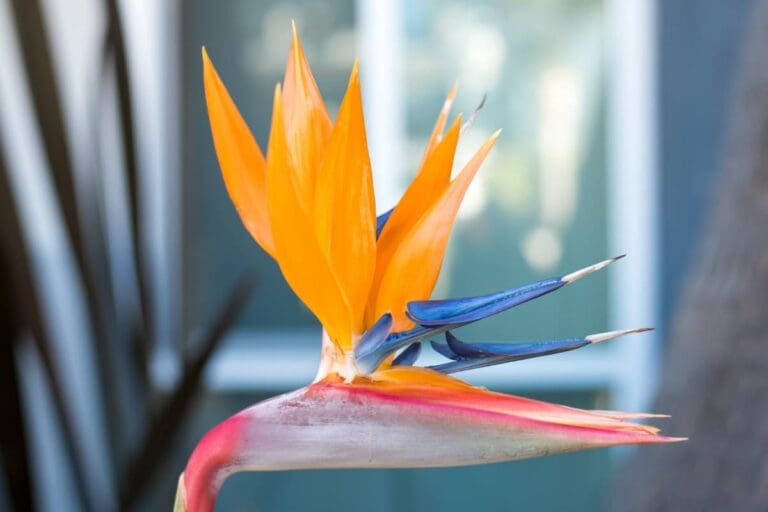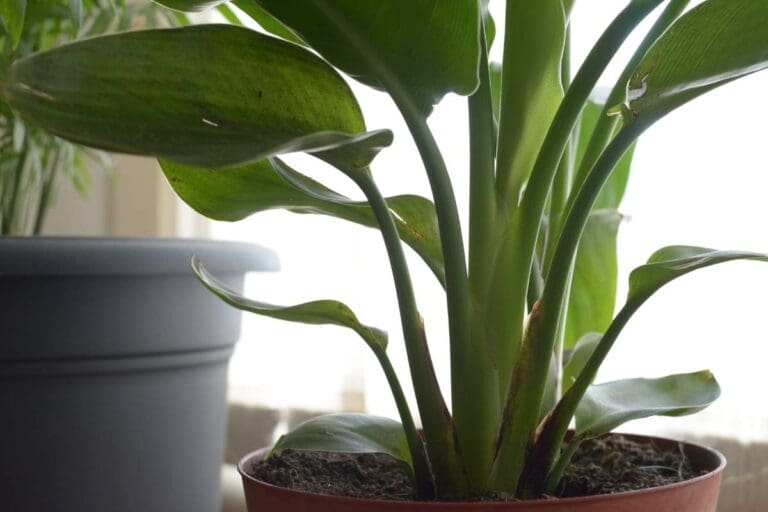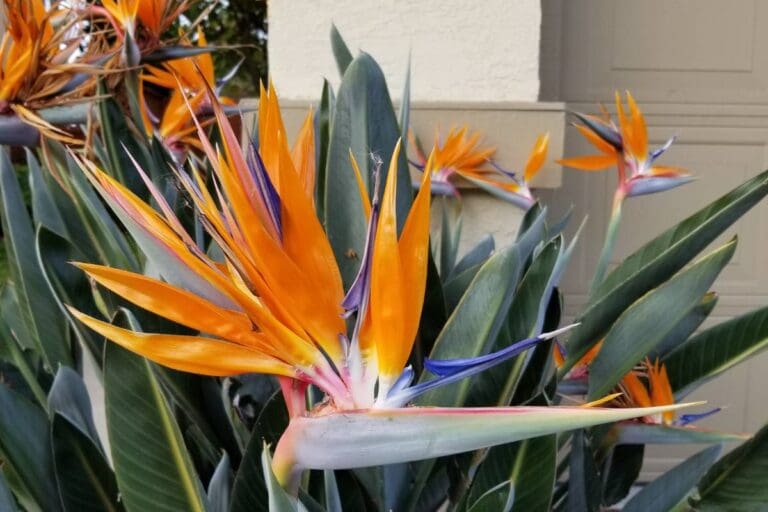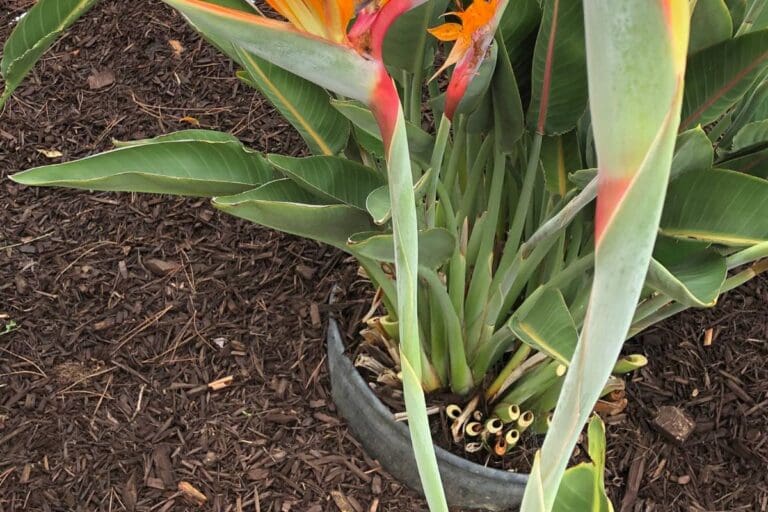How To Treat Spots On Bird Of Paradise Leaves? (Brown, Black, Yellow)
Bird of paradise is famous for its broad foliage. But sometimes, that gorgeous foliage can get spots which can be very upsetting. Even my plant suffered from this.
Brown, Black, or Yellow Spots on bird of paradise leaves can be caused by various factors such as pests, diseases, and environmental stress. Treatment includes removing affected leaves, improving growing conditions, and using appropriate pesticides or fungicides.
This article will discuss each cause in detail and help you treat each problem accordingly. Let’s begin. Shall we?

Please note: Simplify Plants is reader-supported. Some links in the post are affiliate links and I get a commission from purchases made through links in the post.
Identifying the different types of spots
Usually, the bird of paradise can get 4 types of spots:
The color can be different, but the causes are almost the same for each type of spot.
So, don’t get confused.
Understanding the causes of spots on bird of paradise leaves
Various reasons can cause spots on the bird of paradise.
Let’s understand them.
1. Improper watering
Improper watering means you are either overwatering or underwatering.
And both cases can cause spots on your bird of paradise.
But how? Let’s see.
Overwatering
Overwatering is the most common reason behind spots on birds of paradise.
It can make your plant suffer from root rot disease.
Keeping the plant soggy for too long can encourage various fungal diseases to grow inside the soil, causing root rot.
When the roots become infected, they fail to transfer moisture and nutrients to different parts, and the plant starts developing spots on the leaves.
Underwatering
If you often forget to water your bird of paradise, it can cause underwatering.
When a bird of paradise doesn’t receive adequate water, the foliage loses turgor pressure.
Turgor pressure is a force caused by water in a cell that presses down the cell membrane against the cell wall.
Without the turgor pressure, the plant cell loses all its moisture, resulting in spots on the leaves.
2. Incorrect lighting

Both low and high exposure to light can cause spots on the leaves or stems.
If the bird of paradise is exposed to direct sunlight, it breaks down chlorophyll on the foliage, causing brown spots all over the leaves, which will, later on, look like a burn.
On the other hand, if the bird of paradise is not receiving sufficient light, it will not be able to produce chlorophyll which is responsible for the green pigment of the foliage, and the plant will start getting yellow spots all over the leaves.
3. Over-fertilization
Fertilizers, even pesticides, and fungicides contain too many salts in them.
Overuse of these can lead to spots as early signs.
I have made this mistake many times and seen my plant getting spots.
Because of over-fertilization, the toxic salts absorb all the moisture in the soil, leaving the plant dehydrated, which causes yellow or brown spots on the leaves.
4. Nutrient deficiencies
Most people think providing additional plant nutrients is unnecessary.
But let me ask you a question. How do you get energy? By eating food, right?
Similarly, the plant must be fed with nutrients to grow and shine.
If the bird of paradise fails to receive essential nutrients like copper, calcium, manganese, magnesium, and iron, it can develop spots on the leaves, indicating weakness.
5. Wrong temperatures

The ideal temperature for a bird of paradise is 65-85°F.
Even a slight temperature change can be immensely challenging for your plant.
If the temperature drops too low or rises too high, the bird of paradise will fail to adjust to the new environment, causing stress to the plant, and the leaves will eventually show yellow or brown spots.
6. Low humidity
It is vital to keep the surroundings moist for your bird of paradise (At least 60-70%).
If you fail to do so, the transpiration rate increases around your plant, due to which the leaves start losing all of their moisture quickly.
This causes dehydration which harms the leaf’s tissue, causing yellow, brown, or black spots.
7. Edema
Edema is a water retention disorder where roots take up more moisture than the leaves can transpire.
If the water is retained excessively, the cells of the leaves rupture, causing spots all over them.
This happens because the ruptured area expands, leaving spots on the foliage’s bottom and top.
8. Poor drainage

Poor drainage depends on two types, i.e., pot drainage and soil drainage.
If your bird of paradise grows in a pot with few drainage holes, it can frequently suffer waterlogging problems causing spots on the leaves.
On the other hand, if the soil is either highly loose or tight, your plant can suffer from underwatering and overwatering issues more often, which can cause spots on the plant.
9. Pest infestations
Pests are the worst nightmare your bird of paradise can suffer from.
They are not only responsible for the spots, but they can even take your plant’s life.
So, how can pests cause spots on the bird of paradise?
The main motive of pests is to suck out sap from the foliage.
While feeding, they inject toxins into specific areas, later turning into spots.
Let’s discuss each type of pest which will help you to identify them:
- Aphids: They are sap-sucking insects that have soft bodies and piercing mouths.
- Scales: Scales are tiny insects with no legs or heads. Their body is usually covered with a waxy shell, resembling the scales community.
- Mealybugs: They are tiny wingless bugs with a soft body that appears as cottony structure on the plant.
- Spider mites are 4 legged, oval body insects with no antennae. These pests are harder to spot in the plants. For identification, you will see a web-like structure on the plant.
- Whiteflies are easily visible soft-bodied winged bugs that usually feed on the undersides of the leaves.
10. Fungal or bacterial infections
Fungal and bacterial infections usually occur after pests infect the plant.
Pests always excrete a sugary substance called honeydew.
If left untreated for a prolonged period, various fungal or bacterial diseases can begin their growth in those specific areas, leading to spots on the leaves or stems.
Let’s discuss each type of infection in detail to identify them.
Fungal diseases
6 types of fungal diseases can cause spots.
- Fungal leaf spot: Fungal leaf spot is usually caused by a pathogen. You will notice water-soaked brown and black spots with a yellow-colored center.
- Downy mildew: It is a type of fungal disease caused by a fungus called Oomycete. They are usually airborne diseases. The plant usually shows yellow spots all over the leaves.
- White mold: A saprophytic fungus usually causes white mold. They are not considered harmful at all. You will see chalky white spots on the leaves due to this mold.
- Gray mold(Botrytis): An infective mold spreads through the velvet bacteria. You will notice gray or black spots on the leaves, bract, and stems.
- Powdery mildew: Powdery mildew is also a fungal infection that looks like a powdery white substance on the plant. You will notice white powdery spots, which eventually turn brown after some time.
Bacterial infections or virus
- White spot: Here, the spots on the leaves are caused by a fungus called septoria. The spots are usually white with a purple, red, or yellow edge.
- White rot: White rot happens when the roots get damaged by fungal infections. Due to this, the infected roots fail to function, causing spots on the leaves and stems.
- Mosaic virus: Here, the spots on the leaves are caused by a virus. Due to this virus, you will see faded green or yellow spots on the leaves of your plants.
Safe and effective treatment and prevention options for spots on bird of paradise
Now, let’s discuss all the solutions which can help you to fix each problem:
1. Fixing improper watering

Let’s discuss the solutions of overwatering and underwatering separately.
Overwatering
You will have to re-pot your plant to fix severe overwatering conditions.
Purchase a pot slightly bigger than the previous one and get ready with the well-draining soil.
Then, remove the bird of paradise from the current pot, eliminate all the roots, and repot it in the new pot using a new soil mix.
Place the plant in indirect light and avoid watering until the plant recovers from the damage.
Underwatering
Start watering the plant until you notice the water draining from the drainage holes.
Make sure to constantly water a little by taking a gap in between.
I never try to stress my houseplants by simultaneously watering them in huge quantities.
You should also do this.
If your plant receives direct light, change the location to where it will receive indirect light.
Always check the soil’s moisture level before watering the plant to prevent this issue.
You can use a moisture meter or insert a finger inside the soil to check.
2. Fixing lighting

Let’s discuss the solution for both low light and excessive light:
To fix low light
Place the bird of paradise in a brighter location where it will receive sufficient indirect and direct light.
I prefer to keep my indoor plant near east and west-facing windows.
Sometimes, even if you keep the plant in the best possible location, it still lacks light.
To solve this issue, you can use artificial lights instead.
Rotating the plant regularly to provide light in each corner, placing it in the best bright location, and using grow lights can help prevent this problem.
To fix excessive light
First, water the bird of paradise thoroughly to recover it from dehydration.
Relocate the location of your bird of paradise where it will receive indirect light, but not too direct.
Avoid keeping it in south-facing windows.
Provide a shade with sheer curtains to decrease the light intensity.
I always maintain a distance of 5-6 feet from the windows to keep my houseplants.
Try to do this to avoid stress.
Providing proper shade, maintaining cool surroundings, and keeping the plant always hydrated will help you to prevent this problem.
3. Fixing over-fertilization

Stop fertilizing your bird of paradise for a few weeks and prune off all the damaged parts.
Water the soil thoroughly until the extra fertilizer comes from the drainage holes.
If the situation is worse, it is best to repot your bird of paradise using a new soil mix.
I avoid fertilizing my houseplants during winter.
Over-fertilization issues mainly occur due to this.
Fertilizing the bird of paradise with a liquid fertilizer (N-P-K ratio of 10:10:10) by diluting it with water only during the growing season will help prevent this problem.
4. Fixing nutrient deficiencies
If your bird of paradise has spots due to any nutrient deficiency, follow these to fix the issue:
| Nutrient deficiency | Fix |
|---|---|
| Calcium | Add crushed eggshells or lime to the soil. |
| Copper | Add a fertilizer with copper sulfate or copper oxide. |
| Manganese | Apply a manganese-rich leaf fertilizer or manganese-sulfate soil fertilizer to the plant. |
| Magnesium | Apply a mixture of one gallon of water and one tablespoon of Epsom salt to the soil. |
| Iron | You can apply iron chelate or coffee grounds to make iron-rich soil. |
5. Fixing the temperatures
During low temperatures, keep the plant away from frosty doors and windows. Also, avoid placing the plant near refrigerators.
Never keep the plant near heating devices such as radiators, stoves, and open fires during high temperatures.
You can easily maintain the temperature using a thermostat device.
I also use this device during sudden temperature fluctuations.
Checking the temperature with the help of a digital thermometer frequently will help you identify the temperature requirements, which can help prevent this problem.
6. Fixing humidity

There are 5 methods that I know can increase humidity.
Let’s discuss each of them:
- Misting: You can mist the bird of paradise with the help of a spray bottle. It is a temporary solution.
- Applying the pebble tray method: You must take a tray filled with water and pebbles and keep the plant above it. The humidity will increase due to evaporation.
- Keeping bowls: You can keep 3 to 4 bowls filled with water around your bird of paradise. This will also help to increase the humidity.
- Grouping houseplants: You can keep other moisture-loving houseplants with your bird of paradise. The humidity will automatically increase when you water all the houseplants.
- Using Humidifier: If all the methods are complicated, you can purchase a humidifier device to increase the humidity.
Checking humidity around the plant with the help of a hygrometer can help you prevent this problem.
7. Fixing drainage
To fix the pot drainage, you must change the current pot with the new one, which contains more drainage holes.
To increase the soil drainage, add gypsum powder, manure, perlite, coco husk, crushed charcoal, and sand to the current soil.
While on the other hand, to improve the soil’s water retention, you can add vermiculite, peat moss, compost, and clay soil.
If you want to change the entire soil, add ½ part of potting soil and ½ part of peat moss, and a few amounts of perlite and re-pot the plant using this potting soil.
A perfect well-draining soil mix and a pot with suitable drainage holes will help you prevent this problem.
8. Fixing edema
First, fix your watering schedule.
Never let the bird of paradise sit on soggy soil.
Always water after checking the soil’s moisture.
Ensure a well-draining potting mix and a pot with proper drainage holes.
Provide proper air circulation among the plant, and never place houseplants too close to each other.
I maintain a distance of at least 5-6 inches between my houseplants.
Deficiencies of calcium and potassium can make your plant suffer from edema often. So, apply a slow-release fertilizer.
Maintaining a proper watering routine, providing sufficient indirect sunlight, proper aeration, and good drainage will help you prevent this problem.
9. Fixing pest infestation and fungal infections

Fixing pests will automatically make fungal infections disappear.
Let’s discuss the steps:
- Trim all the damaged parts with the help of sterilized pruners.
- Then, keep the bird of paradise in a particular area where no houseplants are present.
- If any pests are visible, remove them with your hands. Make sure to wear gloves.
- Then, give a strong shower to wash away all the pests and powdery fungal infections. You can also use Insecticidal or dish wash soap while showering.
- If the pests are still there, use wet cotton balls dipped in rubbing alcohol, and wipe off the areas.
- Then, look for honeydew and clean the area by rubbing it with the brush.
- Then spray both fungicides and pesticides all over the plant. Make sure to use biological solutions.
- But if the fungal infections have overgrown, you must re-pot the entire plant.
Pruning regularly and spraying the bird of paradise with pesticides every 2-3 weeks will help you to prevent this issue.
Proper pruning techniques for a bird of paradise
It is best to prune the parts with spots that cannot be recovered.
Tools you will need for pruning are safety gloves, disinfected pruners, and rubbing alcohol.
Steps for Pruning:
- Before beginning, sterilize the pruners with rubbing alcohol.
- Then inspect how many leaves have spots on them. In case of too many, choose only a few for pruning. This will avoid sudden stress.
- Then, take your pruner and cut the stems of the leaves close to the base.
- Make sure to do a clean cut without tearing the stems.
- Then, apply a cinnamon powder or paste to the cut to prevent infections.
- Collect all the pruned leaves in a garbage bag and remove them. Also, wash the pruners properly after pruning.
- Make sure to provide proper care to the plant.
- You can again start pruning the remaining leaves after waiting a few days.
Final words
Don’t be upset if you notice spots on your bird of paradise. There is a solution to every problem.
When I saw spots on my houseplant, I immediately identified the exact issue and started treatment at an early stage. Now, my plant is healthy and growing again.
So, don’t worry; you can also fix your bird of paradise and prevent further spots using all the solutions I have mentioned in the article.
Is it possible to make spots disappear from the leaves?
No, it is not possible to fix the spots on the leaves. Keeping them can only drain the energy of your bird of paradise. So, prune the damaged leaves as soon as possible.
Is it okay to prune the leaves during winter?
No, it is not ok to prune the leaves during winter. Disturbing the plant during the dormancy period can stress the plant. So, wait until the growing season arrives.
Reference: Wikipedia
Recommended Garden Supplies
| Product Image | Our Recommended Gardening Supplies | Check Offers! |
|---|---|---|
Top Top
Top
Top
Top
Top
Top
Top
Top | rePotme Houseplant and Tropical Classic Potting Soil Mix | Check Offer On Amazon |
 Top
Top
Top
Top
Top
Top
Top
Top | Espoma Organic Indoor Plant Food | Check Offer On Amazon |
 Top
Top
Top
Top
Top
Top
Top
Top | GooingTop LED Grow Light 6000K Full Spectrum Clip Plant Growing Lamp | Check Offer On Amazon |
 Top
Top
Top
Top
Top
Top
Top
Top | Soil Moisture Meter | Check Offer On Amazon |
 Top
Top
Top
Top
Top
Top
Top
Top | Govee Hygrometer Thermometer, Bluetooth Enabled! | Check Offer On Amazon |
 Top
Top | LEVOIT Humidifiers for Large Room(Best For Plants) | Check Offer On Amazon |
 Top
Top
Top
Top
Top
Top
Top
Top | Upgraded DIY Automatic Drip Irrigation Kit, 15 Potted Houseplants Support | Check Offer On Amazon |
 Top
Top
Top
Top
Top
Top
Top
Top | Stainless Steel Heavy Duty Gardening Tool Set | Check Offer On Amazon |
 Top
Top
Top
Top
Top
Top
Top
Top | Bonide Insecticidal Soap | Check Offer On Amazon |
 Top
Top
Top
Top
Top
Top
Top
Top | Bonide 32 oz Spray Neem Oil for Organic Gardening | Check Offer On Amazon |
 Top
Top
Top
Top
Top
Top
Top
Top | Garden Safe Fungicide | Check Offer On Amazon |






